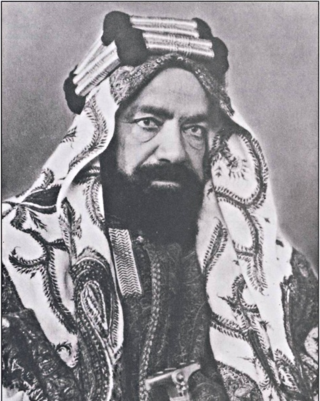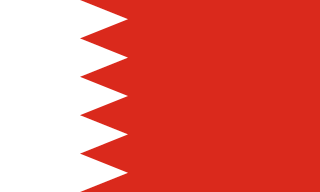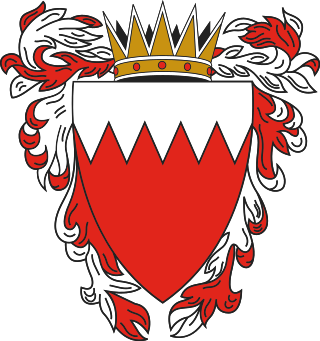
A coat of arms is a heraldic visual design on an escutcheon, surcoat, or tabard. The coat of arms on an escutcheon forms the central element of the full heraldic achievement, which in its whole consists of a shield, supporters, a crest, and a motto. A coat of arms is traditionally unique to the armiger. The term 'coat of arms' itself, describing in modern times just the heraldic design, originates from the description of the entire medieval chainmail 'surcoat' garment used in combat or preparation for the latter.

The coat of arms of Canada, also known as the Royal Coat of Arms of Canada or, formally, as the Arms of His Majesty the King in Right of Canada, is the arms of dominion of the Canadian monarch and, thus, also the official coat of arms of Canada. In use since 1921, it is closely modelled after the royal coat of arms of the United Kingdom, with French and distinctive Canadian elements replacing or added to those derived from the British version.

Khalifa bin Salman Al Khalifa was a Bahraini royal and politician who served as the Prime Minister of Bahrain from 10 January 1970 until his death in 2020. He took office over a year before Bahrain's independence on 15 August 1971. He was the longest-serving prime minister in the world. Under the 2002 Constitution he lost some of his powers, with the King now having the authority to appoint and dismiss ministers.

The coat of arms of Romania was adopted in the Romanian Parliament on 10 September 1992 as a representative coat of arms for Romania. The current coat of arms is based on the lesser coat of arms of interwar Kingdom of Romania, which was designed in 1921 by the Transylvanian Hungarian heraldist József Sebestyén from Cluj, at the request of King Ferdinand I of Romania, it was redesigned by Victor Dima. As a central element, it shows a golden aquila holding a cross in its beak, and a mace and a sword in its claws. It also consists of the three colors which represent the colors of the national flag. The coat of arms was augmented on 11 July 2016 to add a representation of the Steel Crown of Romania.

The House of Khalifa is the ruling family of the Kingdom of Bahrain. The Al Khalifas profess Sunni Islam and belong to the Anizah tribe, some members of this tribe joined the Utub alliance which migrated from Central Arabia to Kuwait, then ruled all of Qatar, more specifically Al Zubarah, which they built and ruled over before settling in Bahrain in the early 17th century. The current head of the family is Hamad bin Isa Al Khalifa, who became the Emir of Bahrain in 1999 and proclaimed himself King of Bahrain in 2002, in fact becoming a constitutional monarch.

Salman bin Hamad Al Khalifa is Crown Prince and Prime Minister of Bahrain. He is also the deputy supreme commander of the Bahrain Defence Force.

The coat of arms of Denmark has a lesser and a greater version.

In Bahrain, the prime minister is the head of government of the country. According to the Constitution of Bahrain, the prime minister is appointed directly by the King, and needs not to be an elected member of the Council of Representatives.
Sir Charles Dalrymple Belgrave KBE was a British citizen and advisor to the rulers of Bahrain from 1926 until 1957, as "Chief Administrator" or "adviserate". He first served under Shaikh Hamad ibn Isa Al Khalifa, and subsequently under his son, Shaikh Salman.

The coat of arms of Portugal is the main heraldic insignia of Portugal. The present model was officially adopted on 30 June 1911, along with the present model of the Flag of Portugal. It is based on the coat of arms used by the Kingdom of Portugal since the Middle Ages. The coat of arms of Portugal is popularly referred as the Quinas.

Portuguese heraldry encompasses the modern and historic traditions of heraldry in Portugal and the Portuguese Empire. Portuguese heraldry is part of the larger Iberian tradition of heraldry, one of the major schools of heraldic tradition, and grants coats of arms to individuals, cities, Portuguese colonies, and other institutions. Heraldry has been practiced in Portugal at least since the 12th century, however it only became standardized and popularized in the 16th century, during the reign of King Manuel I of Portugal, who created the first heraldic ordinances in the country. Like in other Iberian heraldic traditions, the use of quartering and augmentations of honor is highly representative of Portuguese heraldry, but unlike in any other Iberian traditions, the use of heraldic crests is highly popular.

Hamad ibn Isa Al Khalifa KCIE, CSI was the Hakim (ruler) of Bahrain from the death of his father, Hakim Isa ibn Ali, on 9 December 1932 until his own death in 1942.

Isa ibn Ali Al Khalifa was the ruler of Bahrain from 1869 until his death. His title was Hakim of Bahrain. He is one of the longest reigning monarchs of the region, a reign lasting 63 years. He was forced by the British political advisor, Clive Kirkpatrick Daly, to abdicate in 1923, although this "abdication" was never recognised by Bahrainis who considered his successor Hamad only as a viceruler until Isa's death in 1932.

The following outline is provided as an overview of and topical guide to Bahrain:
Umm as Sabaan is an islet in Bahrain. It lies off the north western corner of Bahrain Island, near Budaiya village, and east of Jidda Island, located in the Persian Gulf. It lies 15 km (9.3 mi) west of the capital, Manama, on Bahrain Island.

The Cabinet of Bahrain is the chief executive body of the Kingdom of Bahrain. According to Article 32 (b) of the 2002 Constitution, "executive authority is vested in the King together with the Council of Ministers and Ministers". The Council of Ministers (Cabinet) is appointed directly by the King . Bahrain has had only two Prime Ministers since the country's independence in 1971, Khalifah ibn Sulman al-Khalifah, the uncle of the reigning King Hamad ibn Isa al-Khalifah. Khalifah ibn Sulman al-Khalifah died on 11 November 2020, and was succeeded by the King's son, Crown Prince Salman. As of 2010, roughly half of the cabinet ministers have been selected from the Al Khalifa family, including the Minister of Defence, Minister of Interior, Minister of Foreign Affairs, Minister of Finance, and Minister of Justice and Islamic Affairs.

The National Security Agency (NSA) or Bahrain Intelligence Agency (BIA1) is an investigating authority in Bahrain that is associated with but not formally part of the Ministry of the Interior. The NSA was formed after King Hamad issued Decree No. 14 of 2002 declaring it as the replacement of the General Directorate for State Security Investigations. The NSA was granted the power to make arrests by a 2008 royal decree, and lost this power in 2011, again by royal decree.

Rashid bin Abdullah Al Khalifa is a member of the Bahraini royal family and since 2004 has been the minister of interior of Bahrain.
The administrative reforms of the 1920s were a series of British-led reforms that have laid the foundations of modern Bahrain. They took place between 1919 and 1927, but their background extends to the early 19th century. Britain signed a number of treaties with Bahrain in 1820, 1861, 1880 and 1892. The latter two had effectively turned Bahrain into a British Protectorate. Earlier in 1869, Britain had appointed the young Shaikh Isa ibn Ali Al Khalifa as ruler. Shaikh Isa was an autocrat and a feudal overlord whose authority was shared with his family and Sunni tribal allies. The economy was dependent on pearl diving and palm farming. Both sectors suffered from great inequalities; the conditions of the mostly Baharnah (Shia) peasants and the mostly non-Bahraini divers were often compared to slaves. Since the beginning of the 20th century, the British influence in Bahrain has been on the rise; in 1904-5 they extended their jurisdiction over all foreigners and in 1913 issued an Order in Council, which effectively turned Bahrain into a colony. The Order was not implemented until after the end of World War I.
















